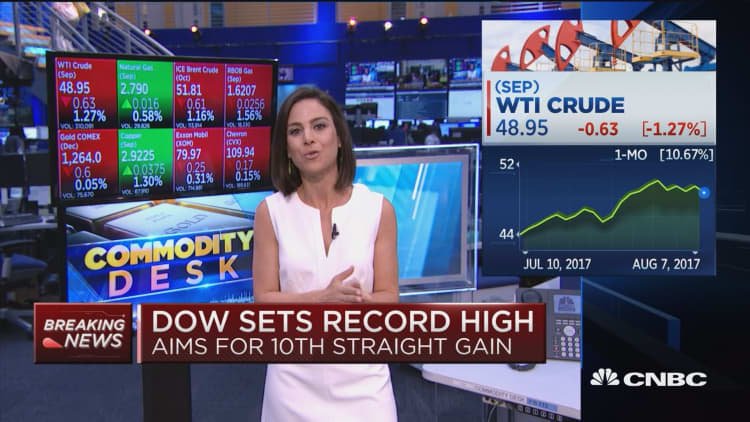Oil prices slipped in choppy trade on Tuesday as rising output and exports from large producers offset news of lower crude supplies from Saudi Arabia.
The crude market has been in consolidation mode after a sharp rally between mid-June and late July that pushed U.S. crude futures above $50 a barrel for the first time in several weeks. Since then, crude has traded around that number as world supply has been slow to draw down.
"It's just unable to break above $50," said Kyle Cooper, consultant for ION Energy in Houston. "It's boring, but there's a fundamental justification for prices being stuck between $45 and $55 without a significant geopolitical event."
U.S. crude ended Tuesday's session down 22 cents at $49.17 a barrel. Global benchmark Brent crude futures were down 27 cents at $52.10 a barrel by 2:29 a.m. ET (1829 GMT).

Saudi state oil company Aramco will cut allocations to its customers worldwide in September by at least 520,000 barrels per day (bpd), sources familiar with the matter told Reuters on Tuesday.
The cut is in line with the kingdom's commitments in a supply reduction pact led by the Organization of the Petroleum Exporting Countries designed to bolster oil prices that have been depressed for more than three years by a global glut.
Production from Libya's 270,000 bpd Sharara field is returning to normal after a disruption when protesters broke into a control room, the National Oil Corp said. Libya pumped 1.03 million bpd in July, according to the latest Reuters survey.
OPEC output hit a 2017-high in July and its exports were at record levels.
Officials from a joint OPEC and non-OPEC technical committee are meeting in Abu Dhabi on Tuesday to discuss ways to increase compliance with the deal to cut 1.8 million bpd in production.
Oil production remains high in many parts of the world and fuel prices are around half what they were in 2011-2014. Many U.S. shale drillers, in reporting second quarter earnings, highlighted efforts to improve drilling efficiencies to boost profits, but largely expect to keep pumping oil.

"Everything on the (earnings) calls out of Q2 are highlighting efficiency gains, keeping capital restraint, but yet they still have production growth," said Cooper.
The U.S. Energy Information Administration, part of the Energy Department, will release its weekly petroleum status report at 10:30 a.m. (1430 GMT) on Wednesday, giving details on stockpiles and refinery runs.
U.S. crude inventories were expected to have posted their sixth straight weekly decline last week, while refined product stockpiles probably fell too, a preliminary Reuters poll showed on Monday.
Later on Tuesday the American Petroleum Institute, will release its own report on stockpiles and refinery throughput.
Oil output in the United States has risen this year, although Baker Hughes data on Friday showed a cut of one drilling rig in the week to Aug. 4.

